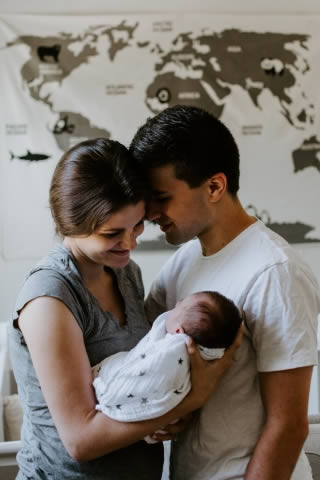
Many women experience lower libido, vaginal dryness, sore muscles, and tender skin in the genital area after childbirth.
These issues can make sex uncomfortable, or even unappealing.
Many women are not comfortable bringing up their sex lives to their doctors and midwives, thinking that it “will get better with time.” However, if you find your sexual health impacted for more than a few months after childbirth, you might start to wonder when you’ll be feeling back to normal.
Hormones Can Cause Vaginal Dryness
After delivery, estrogen levels drop and progesterone levels stay high, especially if you’re breastfeeding. This shift in hormones causes dryness of the vaginal tissues. If dryness if your main problem, try a water based lubricant and make sure you’re drinking enough water.
Genital Skin and Muscle Pain
Muscle and skin pain is common postpartum, especially if there was tearing during the delivery. If you are feeling muscle and skin pain, try placing an ice pack to the perineum (the area between your vaginal opening and your anus). Performing Kegel exercises will also promote healing by increasing local circulation. Keeping the area clean with the use of a perineal irrigation bottle and sitz baths will reduce infection and further assist in the healing process. Use of a doughnut cushion provides relief for perineal wound pain in some patients. Finally, keeping bowel movements soft will minimize stress on any sutured and healing sites, thereby minimizing pain.
Vaginal Scar Pain
Scars from episiotomy or natural tearing can cause pain with tampon insertion or pain with intercourse. An easy self treatment is doing perineal massage over the scar, with a finger/thumb or a small vibrator.
Orthopedic Issues
Other women may experience central pubic pain during their vaginal delivery. This could be due to a sprain or separation of the pubic symphysis joint. This will lead to pain over this area, sacroiliac joints, buttocks or thighs. You may feel pain with turning in bed, transitioning from a seated to standing position, getting in and out of a car, or with weight-bearing activities. The pain might be so severe that you are not even thinking about sex.
If this is the case, consider contacting a pelvic floor therapist to receive advanced manual techniques to restore alignment, reduce muscle spasm, and to receive guidance with stabilization exercises that will strengthen the area without making pain worse.
What is Post-Partum Pelvic Floor Therapy Look Like?
Treatment will consist of:
- Myofascial/connective tissue release
- Postural training
- Gait and body mechanic training
- Ergonomics (i.e. workstation, office desk set-up)
- Activity modifications to assist with pain provoking tasks and to prevent injury or repetitive stress on muscles and joints
- Strengthening and stabilization training (this would be tailored to the individual and based upon what stage of gestation you are)
- Stretches to address myofascial restrictions due to bodily changes during pregnancy
- Abdominal strengthening and neuro-muscular awareness of pelvic bracing during functional activities
- Pelvic floor muscle awareness and training to help stabilize pelvis and support
- Pelvic floor downtraining to help with pelvic pain, hip pain, constipation, and pain with sex
Check out these articles on the Femina PT website about pregnancy
- Early Postpartum Recovery, by Heather Jeffcoat, DPT
- Exercises for Low Back Pain in Pregnancy,by Heather Jeffcoat, DPT
- Carpal Tunnel in Pregnancy, by Heather Jeffcoat, DPT
- Help for Pubic Symphysis Pain,by Heather Jeffcoat, DPT
- Post Partum Urinary Incontnence,by Heather Jeffcoat, DPT
- Help for Postural Pain After Breastfeeding,by Heather Jeffcoat, DPT
References:
ACOG, 2005. Your pregnancy and birth. Washington, DC: Meredith Books.
Al Hakim M,. Katirji B. 1994. Femoral mononeuropathy induced by the lithotomy position: a report of five cases with a review of literature. Muscle Nerve 17:4 466.
Babayev M., Bodack M.P., Creatura C. 1998. Common peroneal neuropathy secondary to squatting during childbirth. Obstet Gynecol 91:5 830-832.
Haslam, J., Laycock, J. Therapeutic management of Incontinence and Pelvic Pain.
Therapeutic Management of Incontinence and Pelvic Pain. 2nd edition. Halsam and Laycock.
Ley L., Ikhouane M., et al. 2007. Neurological complication after the “tailor posture” during labour with epidural analgesia. J Gynecol Obstet Biol Reprod 36:5 496-499.
Massey E.W., Cefalo R.C. 1979. Neuropathies of Pregnancy. Obstet Gynecol Surv. 34:7 489-492.
Ronchetti I., Vleeming A., et al. 2008. Physical characteristics of women with severe pelvic girdle pain after pregnancy: a descriptive cohort study. Spine 33:5 145-151.
Snow R.E., Neubert A.G. 1997. Peripartum pubic symphysis separation: a case series and review of the literature. Obstet Gynecol Surv 52:7 438-443.
Stephenson, R., O’Connor, L. 2000. Obstetric and Gynecologic Care in Physical Therapy. New Jersey: Slack, Inc.
Tetzschner T., Sorensen M., et al. 1995. Pudendal nerve damage increases the risk of fecal incontinence in women with anal sphincter rupture after childbirth. Acta Obstet Gynecol Scand 74:6 434-440.
Tetzschner T., Sorensen M., et al. 1997. Delivery and pudendal nerve function. Acta Obstet Gynecol Scand 76:4 324-331.
Wong C.A., Scavone B.M., et al. 2003. Incidence of postpartum lumbosacral spine and lower extremity nerve injuries. Obstet Gynecol 101:2 279-288.
